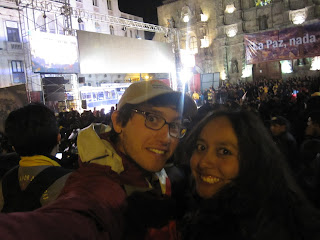 |
| A hen protects the seeds germinating below |
I got to visit the CEIBO plant with David
and others in Sapecho on Thursday. It
smelled better than anything industrial I have ever smelled except perhaps the
Malto-meal factory when the winds would blow from the south toward Carleton. What smelled so good was the fermenting and
drying cacao beans—like a slightly sour chocolate, very hard to describe really
and probably not worth it. This was
actually the last and most visible step of the cacao preparation process. It was quite a processing plant. All of the cacao that CEIBO produces—over
6million dollars in sales (which makes it the largest producer in Bolivia)
passes through this plant's warehouse—most of it gets fermented and dried here
as well. But that is only the base of
the pyramid that has by now grown to mammoth proportions. CEIBO runs a seed bank, plant nursery and
research area, as well as an actual lending bank all for the benefit of it's
many members.
 |
| Moniliasis--the epidemic destroying cacao harvests |
The seed bank and nursery
are run by Bambi, Ana Maria's daughter, who is an agro-forestry expert. They not only keep and produce cacao plants,
but also many varieties of fruiting and lumber tree species that can co-exist
with cacao production. Saturday I was
able to work in the nursery seeding new cacao plants of which they have tens of
thousands, and got to see how these funny plants get their start.
 |
| A recently sprouted cacao plant. That seed stays attached for a while |
Over this time I have also learned a good
deal about the economics of agricultural production in the Alto Beni and
Caranavi, in general. From a broad
perspective, most plots of land are about 10 hectares, which is fairly
large. If planted with cacao, this
usually does not make up more than 50% of the land. In fact, cacao is less profitable than papaya
for instance, and has around the same margin currently as coffee—and with labor
prices high here, a land owner makes a small margin indeed on any agricultural
product. That coupled with the fact that
cacao and coffee are single-season crops, has led to increased desire for
diversification. Economics however are
not the only thing pushing cacao producers toward other crops, Moniliasis, or
Monilia as it is known widely has infected the area. This plague can wipe out entire crops,
greatly reducing the productivity of a region.
But Monilia is like almost no human plague—no medicine exists, organic
or conventional, to control it.
Varieties that are resistant are either of lower quality (CC51) or
produce little (though delicious) fruit (Creole). And planting new cacao means waiting between
4 and 6 years before producing—feeding the inertia of any agricultural
system. It is a problem that at meetings
with local cooperatives I heard voiced forcefully and repeatedly. It is a conundrum.
 |
| There were thousands of plants. |
Meanwhile, back in Caranavi I await a
organics fair known as Bio Caranavi where Diane (of Artesania Sorata) is
presenting a water turbine for use on small farms in the area. Yumm I can smell the fried chicken even from
my hostel window. At least lodging is
cheap.














